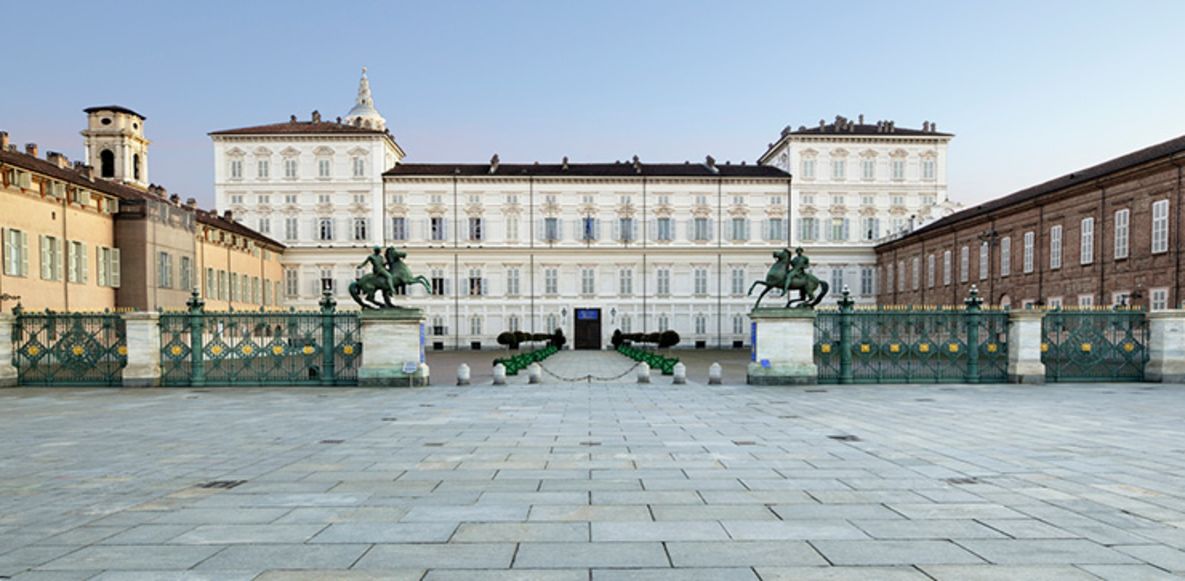Discover the Savoy splendour of Turin's Royal Palace
A UNESCO Heritage site since 1997, the Royal Palace of Turin belongs to the complex of the Royal Museums along with all its dependencies: the Gardens, the Library, the Royal Armory, the Sabauda Gallery, the Archaeological Museum, the Chiablese Halls and the Chapel of the Shroud. Designed starting from the end of the 16th century by Ascanio Vittozzi and Carlo di Castellamonte, it is inspired by the Palace of Versailles and stands out for its unmistakable Baroque style. It was the residence of the House of Savoy until 1865. Today it hosts exhibitions and cultural events. An icon of Turin, with its sumptuous central façade and two higher side wings, it dominates the opposite Piazza Castello and undoubtedly represents the starting point for a visit to the capital city of Piedmont.
Palazzo Reale: from the Savoys, to the Unification of Italy up to the Monarchy
The core of the Savoy court and of the political power whose protagonists were Victor Amadeus II of Savoy and Carlo Emanuele, the Royal Palace and the buildings surrounding it represented the command and representation center of Savoy magnificence. Over the centuries, the building has undergone numerous renovation interventions entrusted in the 18th century to Juvarra and Alfieri and in the 19th to Palagi, thus making Royal Palace a unique construction that harmonizes different architectural styles and not only the Baroque. It starts from the elegance of the 17th-century façade and continues with the splendor of the furnished halls, eloquent mirror of the lavish court life and the centuries-old history of the House of Savoy.
With the Unification of Italy, the Royal family moved to Florence and left Palazzo Reale, which remained one of the Savoy possessions, while with the fall of the king and the Monarchy, in 1946, the structure was abandoned and many halls were even sealed, only to return to new life in 2007, when the palace was reopened to the public.
The extraordinary halls and dependencies of the Royal Palace of Turin
The Ballroom, the Throne Room, the Salone degli Svizzeri, Council Room as well as the Scissors Staircase and the Chinese Cabinet designed by Filippo Juvarra. Royal Palace is a solemn and composite work that has stratified over the centuries starting from the last years of 1500, when Turin became the capital of the duchy and Emanuele Filiberto di Savoia established his residence in the old bishop's palace. In 1643, the first embellishments of the royal apartments on the first floor proceeded: carved gold ceilings and large allegorical canvases by Jan Miel and Charles Dauphin.
In 1688, the painter Daniel Seyter intervened from Rome, frescoing the gallery and Madame Felicita's apartment together with Bartolomeo Guidobono. With the achievement of the royal title by Victor Amadeus II, the command area with the Secretariats, Offices, Royal Theater and State Archives was annexed to the palace. The garden layout was also revised and expanded by the Frenchman André Le Nôtre.
The Scala delle Forbici, built for the marriage between Carlo Emanuele III, heir to the throne, and Christina of Bavaria-Sulzbach, leads to the apartments of the two consorts on the second floor and is characterized by a pincer-like layout and a frieze in the shape of scissors that, corresponding to the suspended vault, cut two braids creating a singular bifurcated tongue: an allusion and provocation by Juvarra to court gossip.
The Royal Gardens, the Royal Armory, the Sabauda Gallery and the Archaeological Museum make up the entire monumental complex in the center of Turin. The Armory is an extraordinary collection of armors and weapons from the Neolithic period to the Savoy period passing through the Middle Ages and over 33,000 ancient coins. The Sabauda Gallery is a walk among the masterpieces of Tintoretto, Mantegna and Rubens while the Archaeological Museum, created in the 16th century by the Savoys, represents an important and extraordinary cultural center with the artifacts of prehistoric and protohistoric Italic, Latin, Cypriot, Egyptian and related antiquities.
The historic surroundings of the Royal Palace of Turin
Like most of the monuments, residences and places of interest in Turin, the Royal Palace is in the heart of the urban center, an ideal point to visit the other historic sites of the city. In fifteen minutes on foot you can reach the Mole Antonelliana, an imposing 187-meter domed building, and in just five minutes Porta Palatina, an important monument of Turin, a result of the remains belonging to the Roman domination of the urbs. A walk to the Royal Museums is also a must nearby. Exiting Piazza Castello, take Via Garibaldi, at the end of which you will find Piazza Statuto, one of the last of the Risorgimento history of Italy's Savoyard capital. In just under ten minutes on foot, heading south, you arrive at Via Lagrange, where you will find the Egyptian Museum, dedicated to the extraordinary civilization of the pyramids. And then, still to the south, just five minutes away, a visit to Piazza San Carlo is also a must.
The Palazzo Reale and the entire complex with the Gardens, the Library, the Royal Armory, the Sabauda Gallery, the Archaeological Museum, the Chiablese Halls and the Chapel of the Shroud represent a museum project of extraordinary artistic, historical and architectural heritage on an international level. A 3-kilometer tour, also with a guided visit, that retraces the city's events, from the first Roman settlement to the Unification of Italy.
Among the residences of Turin, the Royal Palace is one of the most extraordinary centers of interest in the city. Built at the behest of royal dynasties, today it is the collective heritage of an entire region, where Baroque reigns in the lavish halls inlaid with gold. Come and discover all its wonders and choose to stay at our B&B HOTEL Torino President, for a regal stay in total comfort, at the best value for money. We await you.



















